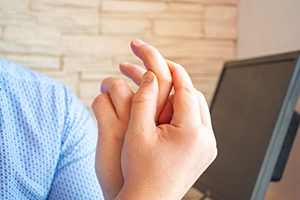Trigger Finger/Thumb: Causes and Treatment
What is Trigger Finger?

It is estimated that there are more than 200,000 cases of trigger finger per year in the United States. This condition is most commonly seen in women between the ages of 40 – 60.
Trigger finger, also known as stenosing tenosynovitis, is a popping or clicking sensation that occurs as you move your finger. Other symptoms of this condition may include tenderness or a bump (nodule) in the palm at the base of the affected finger. When the finger is in a bent position, it may catch or lock, then suddenly pop back into a straight position. The finger may also remain locked in a bent position unable to be straightened. At its most severe, trigger finger can make it difficult to accomplish everyday tasks.
Trigger finger can occur in any finger and even in multiple fingers at a time. When it occurs in the thumb it is called trigger thumb. To understand what causes trigger finger and trigger thumb, it is helpful to understand the mechanisms responsible for moving our digits.
There are two tendons that enter each finger and one tendon in the thumb that control flexion and help the fingers bend. These tendons are covered by a tendon sheath which forms a tunnel that allows the tendons within the fingers and thumb to glide smoothly. Each tendon sheath is made up of bands of tissue called “pulleys.”
When trigger finger occurs, the pulleys at the base of the finger and thumb become inflamed or irritated. Prolonged inflammation of these pulleys, especially of the A1 pulley in the thumb, can cause the tendon sheath to thicken and develop a nodule. The thickening of the sheath makes it more difficult for the tendons to glide within their sheath or tunnel. This leads to the pain, stiffness, swelling and catching of the fingers known as trigger finger.
In severe cases, the finger or thumb can even become stuck in a bent position, forcing the patient to “pop” it back in place.
Meet Our Orthopedic Trigger Finger Specialists
The orthopedic trigger finger specialists at Seaview Orthopaedics are your trusted institute for hand, wrist and elbow orthopedics, injuries, and pain. We are committed to providing high-quality specialized hand, wrist and elbow treatments for our patients.
Schedule An Appointment with Our Trigger Finger Specialists
What Causes Trigger Finger?
There are no known specific causes for trigger finger and trigger thumb. However, certain risk factors predispose individuals to developing this condition.
Risk factors for trigger finger and thumb include:
- Activities that involve repetitive or prolonged gripping such as playing an instrument.
- Medical conditions such as diabetes, thyroid imbalance, and rheumatoid arthritis are associated with trigger finger/thumb.
- Pregnancy – hormonal changes and increased swelling within the tendon sheath make it more difficult for the tendon to glide smoothly.
- There is an association between trigger finger and carpal tunnel syndrome.
Trigger Finger Symptoms
Symptoms of trigger finger and thumb are typically more severe in the morning due to increased hand swelling. Sleeping or laying down for prolonged periods redistributes water in our bodies from our feet into our hands —which worsens hand swelling.
Symptoms may include:
-
- Pain and soreness at the base of the finger or thumb.
- Swelling and stiffness of the finger, especially in the morning.
- A tender lump at the base of the finger or thumb on the palm side of the hand.
- A catching or popping sensation when the finger is flexed or bent.
- In severe cases, locking of the finger or thumb in a bent position which needs to be “popped” back open.
Trigger Finger Examination
Trigger finger and thumb are diagnosed based on a patient’s medical history and a physical examination. X-rays are typically not needed, but they may be helpful to rule out other causes of finger and thumb pain. During the exam, tenderness is checked at the base of each finger and thumb. The fingers and thumb are also checked for catching or locking by bending and straightening these digits.
Schedule Your Trigger Finger Exam Today
Trigger Finger Treatment
At Seaview, we’re committed to utilizing a conservative and minimally invasive approach when working with our patients. We begin your initial trigger finger treatment by exploring non-surgical options and monitoring your progress over time.
Your physician may advise you to avoid forceful gripping activities or may prescribe a splint to keep your affected fingers straight overnight. These non-surgical options have been shown to be helpful in the treatment of trigger finger. Over the counter pain medication including nonsteroidal anti-inflammatory drugs can also help relieve pain and inflammation. However, if your symptoms do not improve using these modalities, a corticosteroid injection into the tendon sheath at the base of the affected fingers or thumb may be recommended.
There is good news: corticosteroid injections have been shown to help resolve or cure trigger finger in 70-80 percent of patients. However, for some, the effectiveness of the corticosteroid injection only lasts for a few weeks or months. Affected fingers can be injected up to 2 or 3 times before a surgical release is recommended. This is because injecting the same finger with a corticosteroid more than 2 to 3 times could cause the tendon to deteriorate or even rupture.
Corticosteroid injections are less likely to be effective in patients with diabetes as well as those with transiently increased blood glucose levels. Therefore, patients with diabetes should monitor their blood glucose after receiving an injection.
If conservative measures are not effective, surgical treatment will be recommended.
Surgical treatment consists of releasing part of the tendon sheath at the base of the affected finger to allow the tendons to glide smoothly within the finger and thumb. Surgical release typically cures the trigger finger. The procedure is commonly performed in a surgical center under local anesthesia or numbing medicine for the affected finger.
Trigger Finger Surgery Recovery
After surgery, hand exercises are recommended to prevent finger stiffness or reduced range of motion. However, in severe cases where the affected finger has been locked or contracted for a prolonged period, or if the patient was unable to straighten their finger prior to surgery, range of motion may not improve. Surgical release will however improve pain and stop the finger from catching. It is typical to have swelling and soreness at the incision site with swelling and soreness subsiding several months after the procedure.
Trigger Finger Treatments in Central New Jersey and Jersey Shore
At Seaview Orthopaedic & Medical Associates, we have provided quality orthopedic care for over 30 years! Our patients’ total experience with our practice is our number one priority. If you have been suffering from trigger finger, be sure to schedule an appointment with a hand, wrist and elbow specialist at one of our six orthopedic clinics throughout NJ. To learn more feel free to contact us online.





